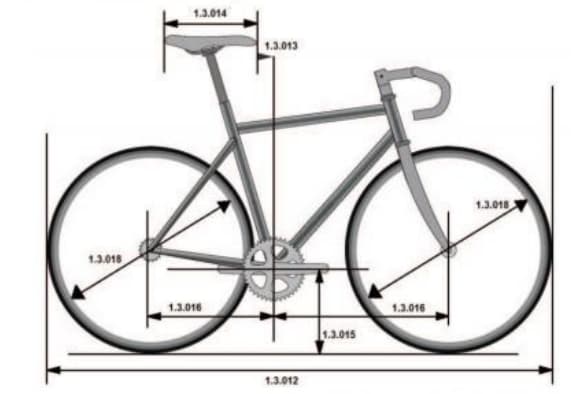Fishy Words
Recumbent Bikes
History
In 1934 the Union Cyclist International defined what exactly counts as a bicycle. These regulations have been used for famous bike races like the Tour de France, as well covering any world records of a bicycle nature.
The regulations only restrict what type of man-powered vehicles are allowed in official “bicycle” races. Manufacturers started building all their bikes to meet the standards because it’s more efficient to have a single design.1 Today most bikes sold in America meet those regulations.

The current UCI regulations can be found at the website https://www.uci.org/ under the “regulations” tab in the top right. At time of writing the “Rules in Force” section links to this PDF for 2023/08/04
The text defines some basic descriptions of the common bike. Two wheels, handlebar steering, pedals turn gears, etc…. But it also defines some extremely specific details. Measurements 1.3.014 says:
The plane passing through the highest points at the front and rear of the saddle can have a maximum angle of nine degrees from horizontal. The length of the saddle shall be 24 cm minimum and 30 cm maximum. A tolerance of 5mm is allowed.
These sort of regulations are not written for the comfort of the rider, nor the speed of the bike. They’re designed to exactly limit the range of bicycles in order to create a fair environment where the best racer wins, not the best bike engineer.
The rules are enforced in order to ensure fairness on the racetrack, but that that doesn’t change the fact the that rules themselves were put in place to stop one specific man from racing on one specific bicycle who was winning too many races in 1933.

Francis Faure set the record for furthest distance “biked” in an hour in 1933.
Bike manufacturers were scaling up production of the standard triangle-frame bike, and wouldn’t want to shift to a new design. It’s unclear from history how much influence the manufacturers had on the UCI’s decision to ban this lay-down bike.
Recumbent Difference
-
Aerodynamics: laying down has far better aerodynamics than traditional sitting. Air resistance is a huge factor in biking: at 10mph it’s 50% of the drag force on the biker! Modern team bike tactics are built around the peloton in order to reduce air drag.
-
More comfortable: the laying posture is nicer than the small hard seats. And the posture doesn’t put weight on the wrists and back. And reduces the stress on the knees. Much kinder to a human body.
-
Easier to balance: the lower center of gravity keeps steady. 3 wheeled recumbent trikes make it trivial.
-
Difficult sharp turns: a two wheeled recumbent has a difficulty making sharp turns
-
Bad suspension: a traditional bike can stand up to avoid bumps, and has easy places for suspension. Recumbents are harder to adjust. going up hills difficult (no standing up leverage)
-
Visibility: recumbent bikes are lower, both making them harder to see, and harder for them to see obstacles. Makes city riding more dangerous.
-
Economics: recumbent bikes are more expensive, partly because they’re more rare (production scale efficiency)
Takeaways
I still ride a traditional triangle-frame bike. I like my current bike and a recument would be more expensive than I’d like. But after a long ride when I feel it in my wrists, back, and knees, I think about how a regulatory vote in 1934 locked in a bike design that might not be optimal for the general public.
-
This is mostly a good thing. It’s nice for ametures to easily buy regulation ready bikes. The UCI encourages this by requireing regulation bikes to be commercially available (§3 Commercialisation 1.3.006) ↩︎